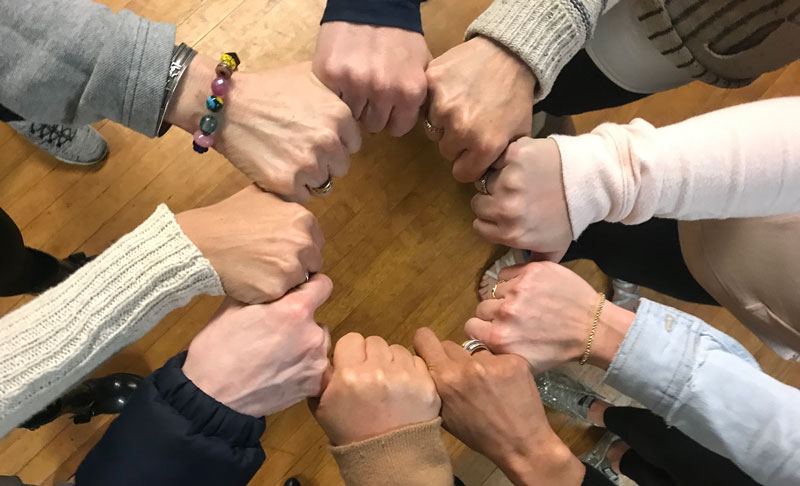
Life is too short to listen to mel robbins
There’s been a lot of buzz about an op-ed published in the New York Times right before Thanksgiving entitled, Life is Too Short…
...
In all the years that I’ve been working with trauma – which has been over three decades – probably the best definition of it that I have ever heard is by Somatic Experiencing® Practitioner and therapist, Dr. Resma Menakem. He defines trauma as anything that is “too much, too fast, too soon, or too long.”
So let’s break that down.
Too much.
Anything that’s too overwhelming for your nervous system is too much. An obvious example of this is being exposed to war. Our bodies are not designed to live with the threat of bombs going off. Seeing people killed or injured and/or living amongst the ruins of our town is more than anyone’s nervous system can tolerate.
Too fast.
For a lot of us, trauma happened as a result of experiencing something that happened too quickly and that overwhelmed our nervous system.
For me, it was going to the emergency room as a seven-year-old because I had just had an accident that broke my leg in two places. Before I could even catch my breath, I woke up in a recovery room. My poor little seven-year-old self had no time to understand what had happened, and so I just pushed the feelings down and carried on because that’s what was expected of me.
Too soon.
Developmentally, for a lot of us, developmentally – meaning the times when we were growing up – we were taking care of our parents at an age when we shouldn’t have been taking care of anybody, or we were taking care of ourselves, and maybe even our siblings before we were supposed to be doing that.
Too long.
I know personally there have been many situations where I have paced myself or thought I could pace myself to deal with or handle a certain situation, and then when it went on too long, my system just couldn’t tolerate it anymore. I’ll give you an example of that. If you become a regular reader of my posts, you will learn very quickly that one of my least favorite things in the world to do is fly.
And so when I get on an airplane, I gear myself up for a certain amount of time. So if I’ve got an hour and a half flight, I’m figuring I’m going to be on the plane about two hours, maybe two and a half hours, depending upon how long it takes us to board and deplane. But if there’s some kind of challenge – if we’re sitting on the tarmac for a long time, or as has happened to me a couple of times – if we can’t land because the airport’s too busy, or there’s weather and we end up circling, my nervous system just gets activated because it’s going on longer than I was prepared for, and I feel trapped.
Because trauma can so easily overwhelm our nervous systems, resulting in things like a strong startle response, nightmares or night terrors, panic attacks, big irritation or even rage as a result of being triggered, etc – we can’t heal from it all at once. We need to work slowly.
In order to help someone working through trauma resolution, we have to first help them feel grounded and centered and calm, or what we call regulating them. Some of the ways we do this is to invite them to feel their feet on the ground, or looking around a space slowly – or what we call orienting – to reassure their system that they’re safe, or connecting to their breathing.
And then we have to slowly dip them into the traumatic memory briefly, so that they can feel the sensations and emotions that they weren’t able to feel at the time it happened, because their system got too overwhelmed and they froze – which was a brilliant way to cope with it at the time. When we dip them back into that, when they start to get overwhelmed, we pendulate them back into a calm and grounded place – inviting them to focus back int the present moment – so they can integrate what has happened and come back to the here and now of relative safety.
It’s kind of like downhill skiing. Unless you’re Olympic champion Lindsay Vaughan, if you go straight down the mountain, you’ll be going too fast, get out of control, and you’ll probably going to hurt yourself, and maybe somebody else.
So how do you get down the mountain? You slalom. You go back and forth, back and forth, making your way safely down the mountain, and staying in relative control of your pace.
So I’ll give you an example of this. When I was in Somatic Experiencing® Training, I was working with someone who had been in a horrible car accident.
Before we touched into the trauma memories, we started by doing some grounding work to help him feel connected, in his body, and safe in the present moment. When we did move him into the traumatic memory, as he started to recall some of it, his body started to get overwhelmed. Now part of the way that I knew this, that I could tell, was he was sitting forward in his chair, leaning on his legs and he was kind of hunched over, staring down at the carpet.
I could feel that he was starting to leave his body and dissociate, or check out. I happened to have my feet propped up on a foot stool, and because it was summertime, it was a really casual environment, and I had been wearing flip flops, I didn’t have my shoes on. And I happened to have had a pedicure that week and had a flower painted on one of my toes.
So as this man – I’ll call him Richard – as he started to leave his body and dissociate, in an effort to pendulate him back into the present moment, I asked him to focus his eyes and find something that was pleasing to look at. Now just as an aside, one of the things that happens for people when they start to dissociate is that their eyes tend to glaze over, or sometimes they actually close them.
So by asking him to keep his eyes open and to find something that he could focus on – and that was potentially even pleasing – I was inviting him to come back to the present moment rather than getting further and further into the past, and into the dysregulation. I had expected him to find something in the carpet – maybe a pattern of some kind – but what he ended up finding was my big toe. And he said, “I’m noticing the snowflake on your toe.”
Now, as I told you, it was a flower, not a snowflake, but I wasn’t about to correct him. So in that moment, I said to him, “Do you like the snow, Richard?” And his body immediately sat up and he got this big smile on his face.
He said, “Oh, I love the snow.” And I asked him to tell me more. And he said, “I remember when I was a little kid, my brother and would play in the snow for hours, and we’d build forts, and we’d build snowmen…”
And I just let him go on and share his memory with me, and as he was doing so, his breathing started to return to normal, his eyes got focused again, and he was animated and energized.
We had touched into the trauma, and then through the pendulation – telling the happy memory of playing in the snow – he pendulated, and his body came back to feeling grounded and present.
When someone starts to dissociate or disconnect, there are any number of ways that we can pendulate them. That might be having them look out the window at a tree or a cloud; it might be smelling flowers or essential oils; it might be holding on to something like a crystal or a pillow or a stuffed animal; it might mean looking at a picture of someone they love; it might mean putting on some music and dancing.
Any of these can help them shift focus back to the present moment. And then potentially, I can invite them to notice their breath, feel their feet on the ground, and help them return back to their body.
So here’s an invitation to you:
Tune into what can help you pendulate back to the present moment. What is it that can give your nervous system a break, and help you come back and feel calm and grounded? Which sense, or type of movement can bring you back to the here and now?
By having that insight in advance, if you encounter a situation that is traumatizing or re-traumatizing, you’ll have a road map back to yourself in the present moment.

There’s been a lot of buzz about an op-ed published in the New York Times right before Thanksgiving entitled, Life is Too Short…
...
Early on in my training, I was taught that the sign of a healthy group is that the sociometry is…
...